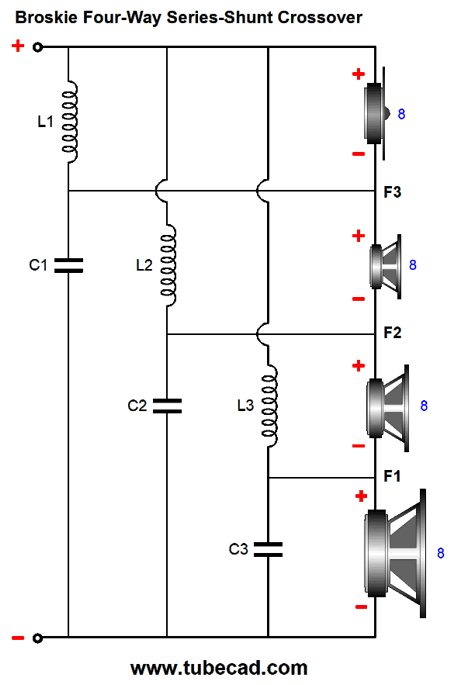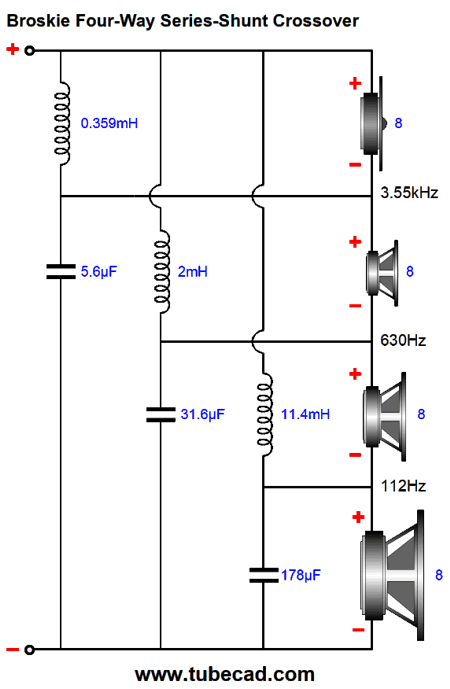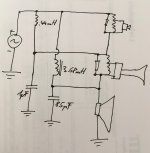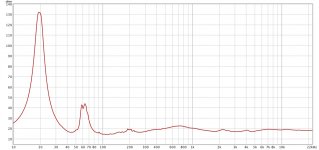Re Broskie Four Way Series-Shunt Crossovers and resistance values.
This is an interesting article with a revised series network topology.
New Crossover Designs
All values in the article are all for 8 ohm values of R but what if you are using drivers with a different values of R?
Assume a 4 way design using a 4 ohm bass / 4 ohm upper bass / 4 ohm upper mids but an 8 ohm tweeter.
Am I right to assume that in theory the component value for the treble C1 will remain as calculated, but that all other component values will obviously change due to the 4 ohm R values?
Usually if impedance R halves then inductor values halve and capacitor values double. Is this the case here?
The only one that would not change would be the 8 ohm tweeter C1 which would still be a 5.6uF capacitor.
Math here
C1 = 159155/R/F3
C2 = 159155/R/F2
C3 = 159155/R/F1
L1 = 1k*R/(2*pi*F3)
L2 = 1k*R/(2*pi*F2)
L3 = 1k*R/(2*pi*F1)
Much fun


This is an interesting article with a revised series network topology.
New Crossover Designs
All values in the article are all for 8 ohm values of R but what if you are using drivers with a different values of R?
Assume a 4 way design using a 4 ohm bass / 4 ohm upper bass / 4 ohm upper mids but an 8 ohm tweeter.
Am I right to assume that in theory the component value for the treble C1 will remain as calculated, but that all other component values will obviously change due to the 4 ohm R values?
Usually if impedance R halves then inductor values halve and capacitor values double. Is this the case here?
The only one that would not change would be the 8 ohm tweeter C1 which would still be a 5.6uF capacitor.
Math here
C1 = 159155/R/F3
C2 = 159155/R/F2
C3 = 159155/R/F1
L1 = 1k*R/(2*pi*F3)
L2 = 1k*R/(2*pi*F2)
L3 = 1k*R/(2*pi*F1)
Much fun


Last edited:
It is a very interesting article and something I would like to try at some point and I'll be very interested to hear of experiences and impressions from anyone who does try it before me.
But - I am missing the boat on why you think the any of the values would not change with a different "R" - by the formulas, and just in general, it looks like they all do.
But - I am missing the boat on why you think the any of the values would not change with a different "R" - by the formulas, and just in general, it looks like they all do.
The R in all the formulas must be the same number, that's how they were derived.
Of course they also assume that all of the drivers have the same efficiency.
The question is what if the drivers are a mix of different R values, i.e. 4 and 8 ohm drivers?
You have to adapt the theoretical formulas to account for differing impedance and efficiency.
His article was a theoretical topology presentation (proof of concept), but not a plug in the
numbers design article. It assumes equal driver impedances and equal driver efficiencies.
You would use a parallel resistance with the tweeter to compensate for the efficiency (instead of
a series tweeter resistance like in the parallel crossover).
To compensate for the impedance, you would add a series resistor with the tweeter (instead of
a parallel tweeter resistor like with the parallel crossover).
These two requirements could be in conflict in some cases, like they can be with the parallel crossover as well.
His article was a theoretical topology presentation (proof of concept), but not a plug in the
numbers design article. It assumes equal driver impedances and equal driver efficiencies.
You would use a parallel resistance with the tweeter to compensate for the efficiency (instead of
a series tweeter resistance like in the parallel crossover).
To compensate for the impedance, you would add a series resistor with the tweeter (instead of
a parallel tweeter resistor like with the parallel crossover).
These two requirements could be in conflict in some cases, like they can be with the parallel crossover as well.
Last edited:
You have to adapt the theoretical formulas to account for differing impedance and efficiency.
His article was a theoretical topology presentation (proof of concept), but not a plug in the
numbers design article. It assumes equal driver impedances and equal driver efficiencies.
You would use a parallel resistance with the tweeter to compensate for the efficiency (instead of
a series tweeter resistance like in the parallel crossover).
To compensate for the impedance, you would add a series resistor with the tweeter (instead of
a parallel tweeter resistor like with the parallel crossover).
These two requirements could be in conflict in some cases, like they can be with the parallel crossover as well.
Thanks rayma, makes sense to try and get a consistent R value throughout and have been playing with the basic math.
Will zobel all units
Definitely, or else they're not a constant R. Also use crossover points that are well above the resonances.
Sum all the (floating) driver outputs to see if it works.
Last edited:
I built the 3 way version for my current speakers. I use autoformers to pad down the mid and tweeter and used a shunt resistor across the autoformer to set impedance to the value the woofer has at it's crossover frequency.
Of course impedance of each driver still isn't a straight line but measured response with the Broskie crossover is exactly the same as the active DSP version I ran to figure out crossover frequencies, slopes and levels.
Of course impedance of each driver still isn't a straight line but measured response with the Broskie crossover is exactly the same as the active DSP version I ran to figure out crossover frequencies, slopes and levels.
The R in all the formulas must be the same number, that's how they were derived.
Of course the formulas also assume that all of the drivers have the same efficiency.
And what of the reality that not very many (maybe none) actaully have an impedance curve that resembles their nominal impedance?
dave
Could you post a schematic of the crossover, and some measurements?
It would help some to apply the basic idea.
Sure. The value for R is 20.8 , crossing at 900Hz and 7k55.
Attachments
And what of the reality that not very many (maybe none) actaully have an impedance curve
that resembles their nominal impedance?
Similar situation with parallel crossovers, use Zobels, etc.
Of course impedance of each driver still isn't a straight line but measured response with the Broskie crossover is exactly the same as the active DSP version I ran to figure out crossover frequencies, slopes and levels.
Then which version do you prefer for the sound, the DSP or the Broskie?
I am just now finishing a 2nd-order 3-way series crossover.
Broskie also published results for ideal drivers (equal and constant 8-ohm, and equal constant sensitivity) for 3-way 2nd-order series configuration in this blog: More on the Series Crossover
As a frequent "series" flyer, those results seemed like something to try. In the end, the results were not close to optimum sound. However, the formulas for R, C, and L provided a starting point. A good starting point is needed to head off in the right direction, especially for series crossovers.
I also used a Zobel on the midrange and on the woofer, to flatten the impedance. The dcr for each of those drivers were around 6 ohms, so the formulas were scaled appropriately. My tweeter was 3 ohms, so more scaling (guessing) was used.
For frequencies below the effectiveness of the Zobel (e.g. driver resonance), the impedance is still not flattened, which counters the initial "ideal" assumption that the formulas were based on.
The real SPL responses also are very non-ideal, which is also a big influence.
That being said, the formulas seemed to give me a reasonable starting point. Series crossovers need a decent starting point. With the simulation software (LspCad), I was able to iterate to a crossover that looked worthy of slinging solder. Several more revisions to the crossover were made over the following weeks to get where it is now.
Long story short - depending on the complement of non-ideal drivers, the formulas may at least get you in the ball park for a starting point.
Sometimes it's all about the journey. There's lots to learn, and it can be fun. Good luck.
Broskie also published results for ideal drivers (equal and constant 8-ohm, and equal constant sensitivity) for 3-way 2nd-order series configuration in this blog: More on the Series Crossover
As a frequent "series" flyer, those results seemed like something to try. In the end, the results were not close to optimum sound. However, the formulas for R, C, and L provided a starting point. A good starting point is needed to head off in the right direction, especially for series crossovers.
I also used a Zobel on the midrange and on the woofer, to flatten the impedance. The dcr for each of those drivers were around 6 ohms, so the formulas were scaled appropriately. My tweeter was 3 ohms, so more scaling (guessing) was used.
For frequencies below the effectiveness of the Zobel (e.g. driver resonance), the impedance is still not flattened, which counters the initial "ideal" assumption that the formulas were based on.
The real SPL responses also are very non-ideal, which is also a big influence.
That being said, the formulas seemed to give me a reasonable starting point. Series crossovers need a decent starting point. With the simulation software (LspCad), I was able to iterate to a crossover that looked worthy of slinging solder. Several more revisions to the crossover were made over the following weeks to get where it is now.
Long story short - depending on the complement of non-ideal drivers, the formulas may at least get you in the ball park for a starting point.
Sometimes it's all about the journey. There's lots to learn, and it can be fun. Good luck.
Last edited:
Then which version do you prefer for the sound, the DSP or the Broskie?
It's been a few months since I switched from the active to the passive system. If I remember it right then there was very little difference with the amplifiers used. For the active development rig I used six LM1785 and when the passive Broskie was getting built and tested used two of these.
I started a thread (that I need to check back in on....
I also tried a 1st order parallel version that I felt had subjectivly less "snap" and soundstaging was a bit different but that's all such mushy territory that I feel it's not worth typing much about it.
- Status
- This old topic is closed. If you want to reopen this topic, contact a moderator using the "Report Post" button.
- Home
- Loudspeakers
- Multi-Way
- Broskie Four Way Series-Shunt Crossovers and resistance values.

